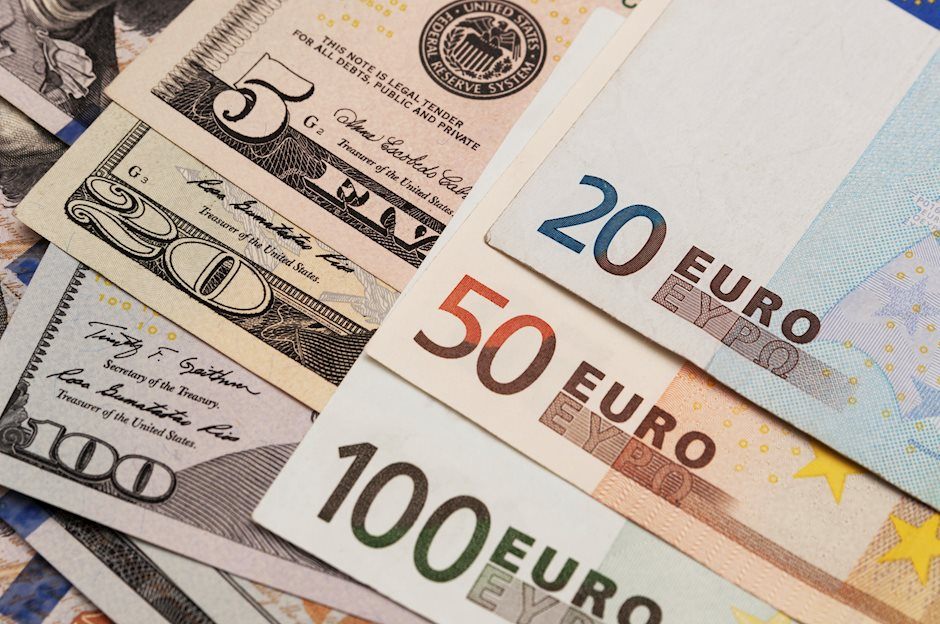EUR/USD Forecast: Improving risk mood could help Euro rebound
- EUR/USD trades marginally higher on the day at around 1.0800.
- The pair could extend its recovery once it confirms 1.0800 as support.
- In the absence of high-tier data releases, the risk perception could drive the pair's action.

EUR/USD holds its ground and trades in a narrow channel at around 1.0800 after closing the fourth consecutive week in negative territory. The positive shift seen in risk mood could help the pair edge higher in the second half of the day.
Euro PRICE Last 7 days
The table below shows the percentage change of Euro (EUR) against listed major currencies last 7 days. Euro was the weakest against the US Dollar.
| USD | EUR | GBP | JPY | CAD | AUD | NZD | CHF | |
|---|---|---|---|---|---|---|---|---|
| USD | 0.64% | 0.66% | 2.55% | 0.54% | 1.59% | 1.59% | 0.45% | |
| EUR | -0.64% | -0.05% | 1.82% | -0.01% | 0.91% | 0.84% | -0.27% | |
| GBP | -0.66% | 0.05% | 1.87% | -0.11% | 0.94% | 0.93% | -0.26% | |
| JPY | -2.55% | -1.82% | -1.87% | -1.96% | -0.92% | -0.88% | -2.10% | |
| CAD | -0.54% | 0.01% | 0.11% | 1.96% | 0.95% | 1.10% | -0.22% | |
| AUD | -1.59% | -0.91% | -0.94% | 0.92% | -0.95% | 0.08% | -1.20% | |
| NZD | -1.59% | -0.84% | -0.93% | 0.88% | -1.10% | -0.08% | -1.18% | |
| CHF | -0.45% | 0.27% | 0.26% | 2.10% | 0.22% | 1.20% | 1.18% |
The heat map shows percentage changes of major currencies against each other. The base currency is picked from the left column, while the quote currency is picked from the top row. For example, if you pick the Euro from the left column and move along the horizontal line to the US Dollar, the percentage change displayed in the box will represent EUR (base)/USD (quote).
The US Dollar (USD) preserved its strength heading into the weekend and forced EUR/USD to stay on the back foot. Rising US Treasury bond yields helped the currency find demand on Friday.
Early Monday, US stock index futures rise between 0.5% and 0.7%. A bullish opening in Wall Street, followed by a risk rally, could weigh on the USD and open the door for an extended EUR/USD rebound in the American session on Monday.
The only data featured in the US economic calendar will be the Federal Reserve Bank of Dallas' Texas Manufacturing Business Index, which is unlikely to trigger a noticeable market reaction. Later in the week, third-quarter Gross Domestic Product (GDP) data from Germany, the Eurozone and the US will be watched closely by market participants. On Friday, the US Bureau of Labor Statistics will release the October employment report, which will include Unemployment Rate, Nonfarm Payrolls and wage inflation figures.
EUR/USD Technical Analysis
EUR/USD was last seen trading near the upper limit of the descending regression channel coming from late September, currently located at 1.0800. Once the pair rises above this level and confirms it as support, technical buyers could show interest. In this scenario, the 50-period Simple Moving Average (SMA) on the 4-hour chart could act as interim resistance at 1.0830 before 1.0870 (200-day SMA).
On the downside, 1.0760 (mid-point of the descending channel) aligns as first support ahead of 1.0710-1.0700 (lower limit of the descending channel, static level).
In the meantime, the Relative Strength Index (RSI) indicator on the 4-hour chart rises toward 50, reflecting sellers' hesitancy.
Euro FAQs
The Euro is the currency for the 19 European Union countries that belong to the Eurozone. It is the second most heavily traded currency in the world behind the US Dollar. In 2022, it accounted for 31% of all foreign exchange transactions, with an average daily turnover of over $2.2 trillion a day. EUR/USD is the most heavily traded currency pair in the world, accounting for an estimated 30% off all transactions, followed by EUR/JPY (4%), EUR/GBP (3%) and EUR/AUD (2%).
The European Central Bank (ECB) in Frankfurt, Germany, is the reserve bank for the Eurozone. The ECB sets interest rates and manages monetary policy. The ECB’s primary mandate is to maintain price stability, which means either controlling inflation or stimulating growth. Its primary tool is the raising or lowering of interest rates. Relatively high interest rates – or the expectation of higher rates – will usually benefit the Euro and vice versa. The ECB Governing Council makes monetary policy decisions at meetings held eight times a year. Decisions are made by heads of the Eurozone national banks and six permanent members, including the President of the ECB, Christine Lagarde.
Eurozone inflation data, measured by the Harmonized Index of Consumer Prices (HICP), is an important econometric for the Euro. If inflation rises more than expected, especially if above the ECB’s 2% target, it obliges the ECB to raise interest rates to bring it back under control. Relatively high interest rates compared to its counterparts will usually benefit the Euro, as it makes the region more attractive as a place for global investors to park their money.
Data releases gauge the health of the economy and can impact on the Euro. Indicators such as GDP, Manufacturing and Services PMIs, employment, and consumer sentiment surveys can all influence the direction of the single currency. A strong economy is good for the Euro. Not only does it attract more foreign investment but it may encourage the ECB to put up interest rates, which will directly strengthen the Euro. Otherwise, if economic data is weak, the Euro is likely to fall. Economic data for the four largest economies in the euro area (Germany, France, Italy and Spain) are especially significant, as they account for 75% of the Eurozone’s economy.
Another significant data release for the Euro is the Trade Balance. This indicator measures the difference between what a country earns from its exports and what it spends on imports over a given period. If a country produces highly sought after exports then its currency will gain in value purely from the extra demand created from foreign buyers seeking to purchase these goods. Therefore, a positive net Trade Balance strengthens a currency and vice versa for a negative balance.
Premium
You have reached your limit of 3 free articles for this month.
Start your subscription and get access to all our original articles.
Author

Eren Sengezer
FXStreet
As an economist at heart, Eren Sengezer specializes in the assessment of the short-term and long-term impacts of macroeconomic data, central bank policies and political developments on financial assets.


















